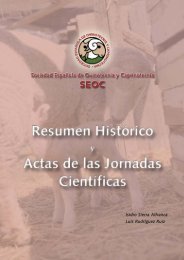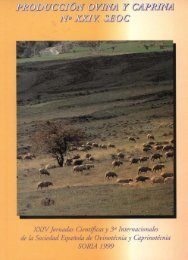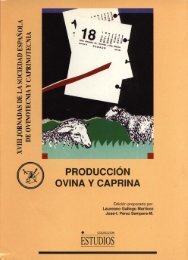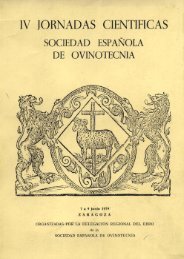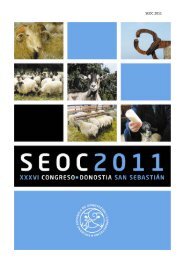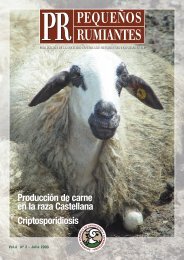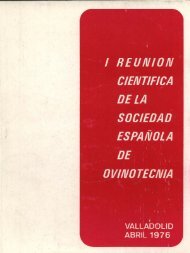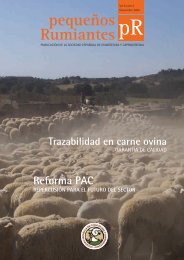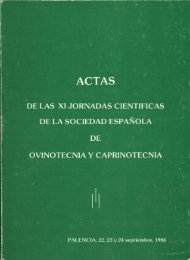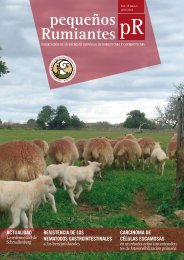- Page 1: PRODUCCIÓN OVINA Y CAPRINAN.º XXI
- Page 4 and 5: COORDINADORESIgnacia Beltrán de He
- Page 6 and 7: 4recursos renovables, pastos, en si
- Page 8 and 9: 6respuestas a los problemas de la p
- Page 10 and 11: 8EVOLUCIÓN ANUAL DE LA DEGRADABILI
- Page 12 and 13: 10GENÉTICASITUACIÓN ACTUAL DEL ES
- Page 14 and 15: 12VALORACIÓN DE UN PLAN DE CONTROL
- Page 16 and 17: 14PRODUCCIÓNANÁLISIS DEL EFECTO D
- Page 18 and 19: 16RESULTADOS EN INSEMINACIÓN ARTIF
- Page 22 and 23: 20BALENT, G. • ALARD, D. • BLAN
- Page 24 and 25: 22BALENT, G. • ALARD, D. • BLAN
- Page 26 and 27: 24BALENT, G. • ALARD, D. • BLAN
- Page 28 and 29: 26BALENT, G. • ALARD, D. • BLAN
- Page 30 and 31: 28BALENT, G. • ALARD, D. • BLAN
- Page 32 and 33: 30BALENT, G. • ALARD, D. • BLAN
- Page 34 and 35: 32VÁZQUEZ, I; CORTÉS, S & BORQUE,
- Page 36 and 37: 34VÁZQUEZ, I; CORTÉS, S & BORQUE,
- Page 38 and 39: 36VÁZQUEZ, I; CORTÉS, S & BORQUE,
- Page 40 and 41: 38SAN PRIMITIVO, F.sin que hasta el
- Page 42 and 43: 40SAN PRIMITIVO, F.ESQUEMA DE SELEC
- Page 44 and 45: 42SAN PRIMITIVO, F.Es impensable ap
- Page 46 and 47: 44SAN PRIMITIVO, F.SITUACIÓN DE LO
- Page 48 and 49: 46SAN PRIMITIVO, F.Cruzamientos par
- Page 51 and 52: Producción Ovina y Caprina • 199
- Page 53: PRINCIPALES PROBLEMAS PARA EL CONTR
- Page 56 and 57: 54 CANO, T.Tabla 1. Evolución de l
- Page 58 and 59: 56CANO, T.Afortunadamente el paso d
- Page 60 and 61: 58GRACIA GASCA, J. & CÁNCER POMAR,
- Page 62 and 63: 60GRACIA GASCA, J. & CÁNCER POMAR,
- Page 64 and 65: 62JUSTE, R. • ARRAZOLA, I. • BE
- Page 66 and 67: 64JUSTE, R. • ARRAZOLA, I. • BE
- Page 68 and 69: 66LÓPEZ-FRANCOS, L.sacrificar anim
- Page 71 and 72:
Producción Ovina y Caprina • 199
- Page 73 and 74:
DEGRADABILIDAD IN VITRO DE SUBPRODU
- Page 75 and 76:
Producción Ovina y Caprina • 199
- Page 77 and 78:
DEGRADABILIDAD IN VITRO DE SUBPRODU
- Page 79 and 80:
Producción Ovina y Caprina • 199
- Page 81 and 82:
EVOLUCIÓN ANUAL DE LA DEGRADABILID
- Page 83 and 84:
Producción Ovina y Caprina • 199
- Page 85 and 86:
COMPARACIÓN PRODUCTIVA Y VALOR NUT
- Page 87 and 88:
Producción Ovina y Caprina • 199
- Page 89 and 90:
PARÁMETROS DE CONTAMINACIÓN EN EF
- Page 91 and 92:
Producción Ovina y Caprina • 199
- Page 93 and 94:
EFECTO DE LA SUPLEMENTACIÓN PREPAR
- Page 95 and 96:
Producción Ovina y Caprina • 199
- Page 97 and 98:
Producción Ovina y Caprina • 199
- Page 99:
UTILIZACION DE BETAINA EN PIENSO DE
- Page 102 and 103:
100SANZ, E. • OVIEDO, G • MIRÓ
- Page 104 and 105:
102SANZ, E. • OVIEDO, G • MIRÓ
- Page 107:
CALIDADDE PRODUCTO
- Page 111 and 112:
Producción Ovina y Caprina • 199
- Page 113:
EFECTO ECONÓMICO EN LA VALORACIÓN
- Page 116 and 117:
114CAÑEQUE, V. et al.El aporte de
- Page 118 and 119:
116CAÑEQUE, V. et al.Tabla 2. Conf
- Page 120 and 121:
118VELASCO, S. et al.la acumulació
- Page 122 and 123:
120VELASCO, S. et al.1982; Aparicio
- Page 125 and 126:
Producción Ovina y Caprina • 199
- Page 127 and 128:
ENGORDE DE CORDEROS TALAVERANOS EN
- Page 129:
ENGORDE DE CORDEROS TALAVERANOS EN
- Page 132 and 133:
130PÉREZ, C. et al.MATERIAL Y METO
- Page 134 and 135:
132PÉREZ, C. et al.C.I.E. 1976. Ce
- Page 136 and 137:
134SÁNCHEZ, A et al.que experiment
- Page 138 and 139:
136SÁNCHEZ, A et al.Composición t
- Page 141 and 142:
Producción Ovina y Caprina • 199
- Page 143 and 144:
Producción Ovina y Caprina • 199
- Page 145 and 146:
APROXIMACIÓN AL ESTUDIO DE LAS CAR
- Page 147 and 148:
Producción Ovina y Caprina • 199
- Page 149 and 150:
ESPESORES DE GRASA, MÚSCULO Y PESO
- Page 151:
ESPESORES DE GRASA, MÚSCULO Y PESO
- Page 154 and 155:
152TOR, M. • DELFA, R. • GOSÁL
- Page 156 and 157:
154TOR, M. • DELFA, R. • GOSÁL
- Page 158 and 159:
156ARGÜELLO, A. • GINÉS, R. •
- Page 160 and 161:
158ARGÜELLO, A. • GINÉS, R. •
- Page 162 and 163:
160MOLINA, M.P. et al.rápida de re
- Page 164 and 165:
162MOLINA, M.P. et al.en el primer
- Page 166 and 167:
164ALTHAUS, RL. • MOLINA, M.P.
- Page 168 and 169:
166ALTHAUS, RL. • MOLINA, M.P.
- Page 170 and 171:
168LANA, M.P. & LASARTE, J.M.Figura
- Page 172 and 173:
170LANA, M.P. & LASARTE, J.M.- La p
- Page 174 and 175:
172LANA, M.P. & LASARTE, J.M.7º Ce
- Page 176 and 177:
174LANA, M.P. & LASARTE, J.M.• El
- Page 178 and 179:
176SERRANO MOYANO, B. et al.Anális
- Page 180 and 181:
178SERRANO MOYANO, B. et al.Figura
- Page 182 and 183:
180ARAMBURU HERNÁEZ, M. et al.dimi
- Page 184 and 185:
182ARAMBURU HERNÁEZ, M. et al.DELA
- Page 186 and 187:
184MOLINA, M. • PÉREZ-ELORTONDO,
- Page 188 and 189:
186MOLINA, M. • PÉREZ-ELORTONDO,
- Page 190 and 191:
188DE VEGA, M.C. • PÉREZ-ELORTON
- Page 192 and 193:
190DE VEGA, M.C. • PÉREZ-ELORTON
- Page 194 and 195:
192BÁRCENAS, P. • PÉREZ-ELORTON
- Page 196 and 197:
194BÁRCENAS, P. • PÉREZ-ELORTON
- Page 199 and 200:
Producción Ovina y Caprina • 199
- Page 201 and 202:
SITUACIÓN ACTUAL DEL ESQUEMA DE SE
- Page 203 and 204:
Producción Ovina y Caprina • 199
- Page 205 and 206:
VALORACIÓN GENÉTICA DE REPRODUCTO
- Page 207 and 208:
Producción Ovina y Caprina • 199
- Page 209 and 210:
POLIFORMISMO GENÉTICO DE LA RAZA M
- Page 211 and 212:
Producción Ovina y Caprina • 199
- Page 213 and 214:
ESTUDIOS GENÉTICOS EN RASA ARAGONE
- Page 215 and 216:
Producción Ovina y Caprina • 199
- Page 217 and 218:
Producción Ovina y Caprina • 199
- Page 219 and 220:
PROGRAMA DE CONSERVACIÓN DE LAS RA
- Page 221 and 222:
Producción Ovina y Caprina • 199
- Page 223 and 224:
LA OVEJA GUIRRA Y SU SITUACIÓN ACT
- Page 225:
GESTIÓN
- Page 228 and 229:
226OLIVER, F. et al.citudes de ayud
- Page 230 and 231:
228OLIVER, F. et al.Tabla 1: Distri
- Page 232 and 233:
230ALVAREZ, S.cinco provincias rest
- Page 234 and 235:
232ALVAREZ, S.desde los centros de
- Page 236 and 237:
234PÉREZ-GUZMÁN, M.ª D. et al.de
- Page 238 and 239:
236PÉREZ-GUZMÁN, M.ª D. et al.ma
- Page 240 and 241:
238KARRERA, I. et al.tores; sin emb
- Page 242 and 243:
240KARRERA, I. et al.Figura 2. Cost
- Page 244 and 245:
242KARRERA, I. et al.Tabla 4 Ingres
- Page 246 and 247:
244URARTE, E. • SEGUROLA, N. & AR
- Page 248 and 249:
246URARTE, E. • SEGUROLA, N. & AR
- Page 250 and 251:
248LANA, M.P. & GARRIZ, I.- Los cos
- Page 252 and 253:
250LANA, M.P. & GARRIZ, I.
- Page 254 and 255:
252LANA, M.P. & GÁRRIZ, I.El núme
- Page 256 and 257:
254LANA, M.P. & GARRIZ, ITabla 2: E
- Page 258 and 259:
256OLIVÁN, A. et al.ciones semiext
- Page 260 and 261:
258OLIVÁN, A. et al.Tabla 1. Resul
- Page 262 and 263:
260SANTAMARÍA, C. et al.“mixtas
- Page 264 and 265:
262SANTAMARÍA, C. et al.Tabla 1. C
- Page 267 and 268:
Producción Ovina y Caprina • 199
- Page 269 and 270:
OVINO DE CARNE: EVOLUCIÓN DE LOS R
- Page 271:
OVINO DE CARNE: EVOLUCIÓN DE LOS R
- Page 274 and 275:
272PÉREZ LAVILLA, J.P. • GIL ROI
- Page 277 and 278:
10DESTORNILLADORES / SCREWDRIVERS /
- Page 279 and 280:
GESTIÓN TÉCNICO ECONÓMICA PARA E
- Page 281:
PATOLOGÍA
- Page 285 and 286:
Producción Ovina y Caprina • 199
- Page 287 and 288:
EVOLUCIÓN DE LA RESPUESTA INMUNE F
- Page 289 and 290:
Producción Ovina y Caprina • 199
- Page 291 and 292:
MEJORA DEL ELISA INDIRECTO PARA EL
- Page 293 and 294:
Producción Ovina y Caprina • 199
- Page 295 and 296:
UTILIZACIÓN DE LA PCR COMO TÉCNIC
- Page 297 and 298:
Producción Ovina y Caprina • 199
- Page 299 and 300:
IDENTIFICACIÓN Y DIFERENCIACIÓN D
- Page 301 and 302:
Producción Ovina y Caprina • 199
- Page 303 and 304:
UTILIZACION DE UNA TECNICA DE PCR P
- Page 305 and 306:
Producción Ovina y Caprina • 199
- Page 307 and 308:
ESTUDIO DE LA DISTRIBUCIÓN DEL RET
- Page 309 and 310:
Producción Ovina y Caprina • 199
- Page 311 and 312:
ANÁLISIS DE LA EVOLUCIÓN DE BRUCE
- Page 313:
ANÁLISIS DE LA EVOLUCIÓN DE BRUCE
- Page 316 and 317:
314LACASTA LOZANO, D. et al.analiz
- Page 319 and 320:
Producción Ovina y Caprina • 199
- Page 321 and 322:
AGALAXIA CONTAGIOSA CAPRINA POR M.
- Page 323 and 324:
Producción Ovina y Caprina • 199
- Page 325 and 326:
REVISIÓN DE LA CASUÍSTICA DE ABOR
- Page 327 and 328:
Producción Ovina y Caprina • 199
- Page 329 and 330:
NIVEL SEROLÓGICO DESARROLLADO TRAS
- Page 331 and 332:
NIVEL SEROLÓGICO DESARROLLADO TRAS
- Page 333 and 334:
Producción Ovina y Caprina • 199
- Page 335 and 336:
PERFÍL SEROLÓGICO DE LA TOXOPLASM
- Page 337:
PERFÍL SEROLÓGICO DE LA TOXOPLASM
- Page 340 and 341:
338RESPALDIZA CARDEÑOSA, E. & RESP
- Page 342 and 343:
340RESPALDIZA CARDEÑOSA, E. & RESP
- Page 344 and 345:
342GARCÍA MARÍN, J. et. al.RESULT
- Page 347 and 348:
Producción Ovina y Caprina • 199
- Page 349 and 350:
INTOXICACION POR PLANTAS EN GANADO
- Page 351 and 352:
Producción Ovina y Caprina • 199
- Page 353 and 354:
Producción Ovina y Caprina • 199
- Page 355 and 356:
ADENOCARCINOMA INTESTINAL EN PEQUE
- Page 357 and 358:
Producción Ovina y Caprina • 199
- Page 359 and 360:
DIAGNÓSTICO DE ENFERMEDADES NERVIO
- Page 361 and 362:
Producción Ovina y Caprina • 199
- Page 363 and 364:
DIAGNÓSTICO DE CASOS NATURALES DE
- Page 365:
PATOLOGÍA:MAMITIS
- Page 368 and 369:
366HERNANDORENA, J.M. • PASCUAL,
- Page 370 and 371:
368HERNANDORENA, J.M. • PASCUAL,
- Page 372 and 373:
370MARTÍNEZ, B. & PERIS, C.sión e
- Page 374 and 375:
372MARTÍNEZ, B. & PERIS, C.paráme
- Page 377 and 378:
Producción Ovina y Caprina • 199
- Page 379 and 380:
UTILIZACIÓN DEL CALIFORNIA MASTITI
- Page 381:
UTILIZACIÓN DEL CALIFORNIA MASTITI
- Page 384 and 385:
382DÍAZ, J.R. • PERIS, C. • FE
- Page 386 and 387:
384DÍAZ, J.R. • PERIS, C. • FE
- Page 388 and 389:
386HERNANDORENA, J.M. • PASCUAL,
- Page 390 and 391:
388LAS HERAS, A. et al.co-sanitaria
- Page 392 and 393:
390LAS HERAS, A. et al.tating ewes
- Page 394 and 395:
392HERNANDORENA, J.M.ª • PASCUAL
- Page 396 and 397:
394ROMEO, M. • JUSTE, R. & MARCO,
- Page 398 and 399:
396ROMEO, M. • JUSTE, R. & MARCO,
- Page 401 and 402:
Producción Ovina y Caprina • 199
- Page 403 and 404:
DIAGNÓSTICO INMUNOLÓGICO POR UNA
- Page 405 and 406:
Producción Ovina y Caprina • 199
- Page 407 and 408:
CASOS CLÍNICOS DE MAMITIS POR Aspe
- Page 409 and 410:
Producción Ovina y Caprina • 199
- Page 411 and 412:
MASTITIS CLÍNICAS ATÍPICAS: DESCR
- Page 413 and 414:
Producción Ovina y Caprina • 199
- Page 415 and 416:
DESCRIPCIÓN DE UN CASO DE MASTITIS
- Page 417 and 418:
Producción Ovina y Caprina • 199
- Page 419 and 420:
EFECTO DE LA MAMITIS SOBRE LA PROTE
- Page 421 and 422:
Producción Ovina y Caprina • 199
- Page 423 and 424:
EFECTOS DEL pH Y EL RECUENTO DE CEL
- Page 425:
EFECTOS DEL pH Y EL RECUENTO DE CEL
- Page 428 and 429:
426MONTES, P. et al.Mastitis Test (
- Page 430 and 431:
428MONTES, P. et al.100090080070060
- Page 433 and 434:
Producción Ovina y Caprina • 199
- Page 435 and 436:
ANALISIS DEL EFECTO DE LA DISTRIBUC
- Page 437 and 438:
Producción Ovina y Caprina • 199
- Page 439 and 440:
ANÁLISIS DE LA INCIDENCIA DE LA CO
- Page 441 and 442:
Producción Ovina y Caprina • 199
- Page 443 and 444:
Producción Ovina y Caprina • 199
- Page 445 and 446:
ESTRUCTURA Y PRODUCTIVIDAD DE LOS P
- Page 447:
ESTRUCTURA Y PRODUCTIVIDAD DE LOS P
- Page 450 and 451:
448ALBIZU, I • BESGA, G. • RODR
- Page 452 and 453:
450ALBIZU, I • BESGA, G. • RODR
- Page 454 and 455:
452MARIJUÁN, S. • RUIZ, R. • M
- Page 456 and 457:
454MARIJUÁN, S. • RUIZ, R. • M
- Page 459 and 460:
Producción Ovina y Caprina • 199
- Page 461 and 462:
ESTUDIO DE EXPLOTACIÓN DE UN REBA
- Page 463 and 464:
Producción Ovina y Caprina • 199
- Page 465 and 466:
ESTUDIO COMPARATIVO DE TRES SISTEMA
- Page 467 and 468:
Producción Ovina y Caprina • 199
- Page 469 and 470:
ESTUDIO COMPARATIVO DE TRES SISTEMA
- Page 471 and 472:
Producción Ovina y Caprina • 199
- Page 473:
COMPORTAMIENTO PRODUCTIVO DE OVEJAS
- Page 476 and 477:
474COMBELLAS, J. DE • RONDÓN, Z.
- Page 479 and 480:
Producción Ovina y Caprina • 199
- Page 481 and 482:
EVOLUCIÓN DEL NÚMERO DE CORDEROS
- Page 483:
EVOLUCIÓN DEL NÚMERO DE CORDEROS
- Page 486 and 487:
484SIERRA, I.el aumento de la produ
- Page 488 and 489:
486SIERRA, I.RESULTADOS Y DISCUSIÓ
- Page 491 and 492:
Producción Ovina y Caprina • 199
- Page 493 and 494:
Producción Ovina y Caprina • 199
- Page 495 and 496:
EL CIERVO (Cervus elaphus), COMPATI
- Page 497:
REPRODUCCIÓN
- Page 500 and 501:
498AGUADO, M.J. et al.cinco de cada
- Page 502 and 503:
500AGUADO, M.J. et al.La pérdida d
- Page 504 and 505:
502PÉREZ-PÉ, R. et al.como distri
- Page 506 and 507:
504PÉREZ-PÉ, R. et al.después de
- Page 509 and 510:
Producción Ovina y Caprina • 199
- Page 511 and 512:
PURIFICACION DE PROTEÍNAS DEL PLAS
- Page 513:
PURIFICACION DE PROTEÍNAS DEL PLAS
- Page 516 and 517:
514ANEL, E. et al.gulada a 40º C.
- Page 519 and 520:
Producción Ovina y Caprina • 199
- Page 521 and 522:
EFECTO DE LA PROPORCIÓN DE YEMA SO
- Page 523 and 524:
Producción Ovina y Caprina • 199
- Page 525 and 526:
ESTUDIO PRELIMINAR DEL PODER FECUND
- Page 527 and 528:
Producción Ovina y Caprina • 199
- Page 529 and 530:
INFLUENCIA DE LA EDAD Y LOS FACTORE
- Page 531 and 532:
Producción Ovina y Caprina • 199
- Page 533 and 534:
ESTUDIO COMPARATIVO DE DOS SISTEMAS
- Page 535:
ESTUDIO COMPARATIVO DE DOS SISTEMAS
- Page 538 and 539:
536MARTÍ, J.I. et al.glucídicos d
- Page 540 and 541:
538MARTÍ, J.I. et al.Tabla 1. Tinc
- Page 543 and 544:
Producción Ovina y Caprina • 199
- Page 545 and 546:
EVOLUCION DE RESULTADOS DE INSEMINA
- Page 547:
EVOLUCION DE RESULTADOS DE INSEMINA
- Page 550 and 551:
548HERRERA, J. & TAPIA, A.sin lavad
- Page 553 and 554:
Producción Ovina y Caprina • 199
- Page 555:
CARACTERÍSTICAS MORFOMÉTRICAS DEL
- Page 558 and 559:
556ROY, T.J. • GIL, M.C. • SÁN
- Page 561 and 562:
Producción Ovina y Caprina • 199
- Page 563:
EFECTO DE LA SUBNUTRICIÓN SOBRE LA
- Page 566 and 567:
564FORCADA, F. • ABECIA, J.A. •
- Page 568 and 569:
566FORCADA, F. • ABECIA, J.A. •
- Page 570 and 571:
568CRUZ, V. et al.Grupo 4) hembras
- Page 572 and 573:
570CRUZ, V. et al.70605040302010029
- Page 574 and 575:
572GONZÁLEZ DE BULNES, A. et al.de
- Page 576 and 577:
574GONZÁLEZ DE BULNES, A. et al.DI
- Page 578 and 579:
576GONZÁLEZ DE BULNES, A. • OSOR
- Page 581 and 582:
Producción Ovina y Caprina • 199
- Page 583 and 584:
INFLUENCIA DE LA ÉPOCA DE NACIMIEN
- Page 585 and 586:
Producción Ovina y Caprina • 199
- Page 587 and 588:
SELECCIÓN DE SEXO EN MUFLÓN EN FU




